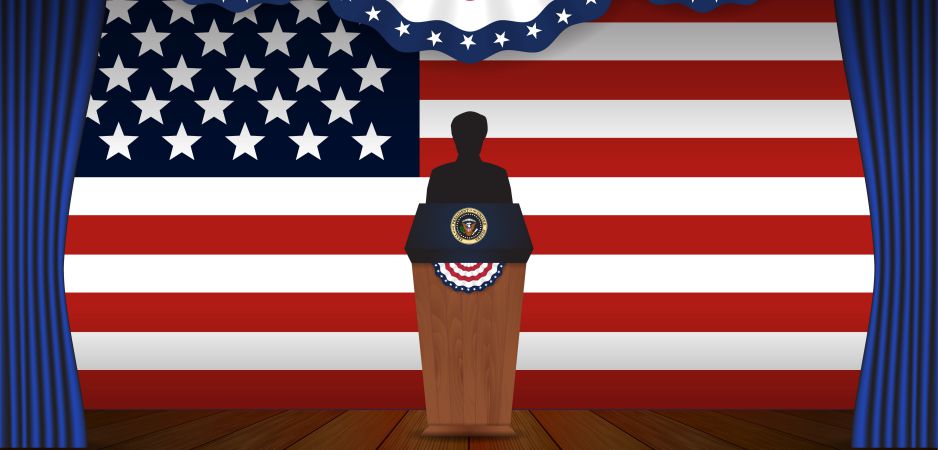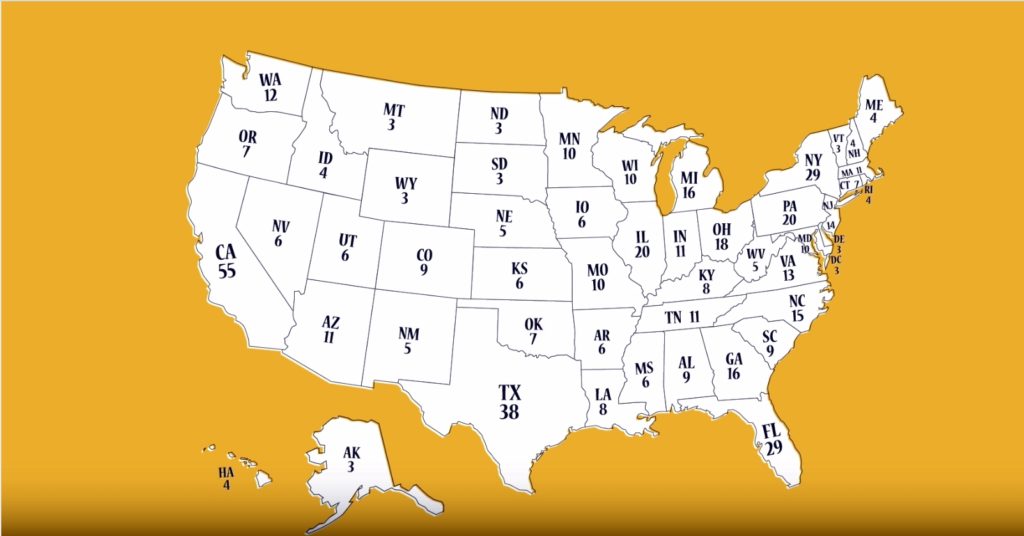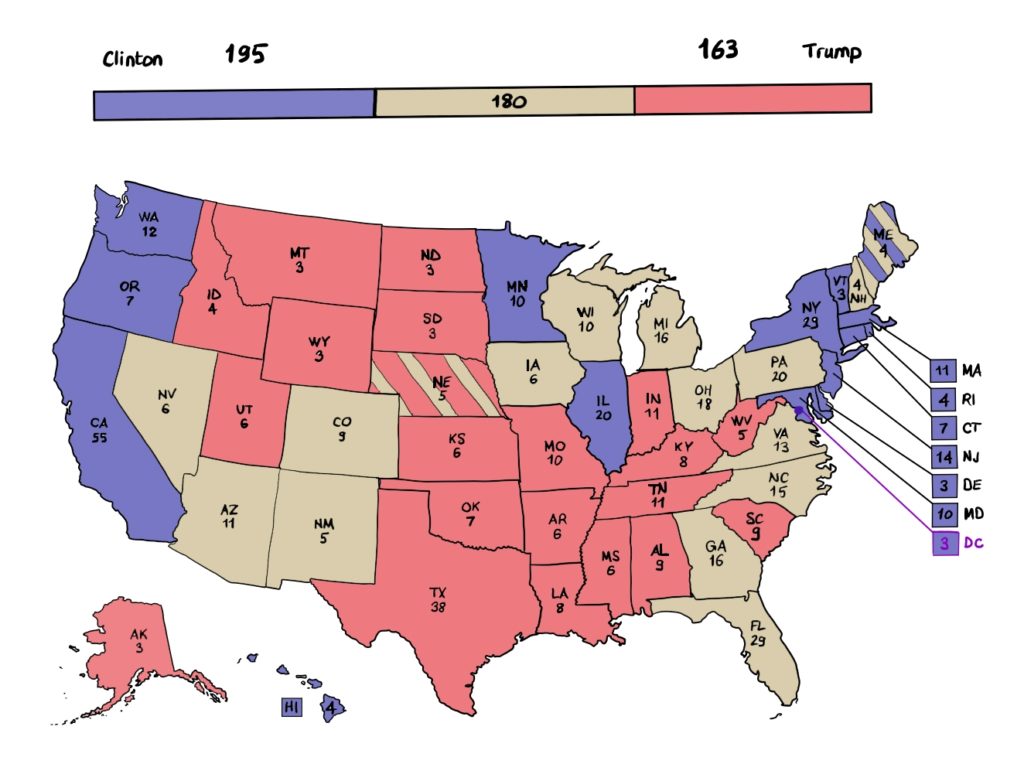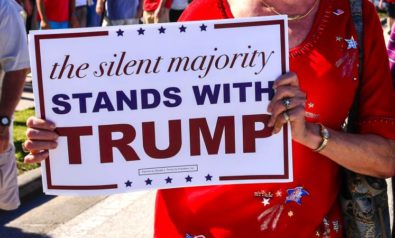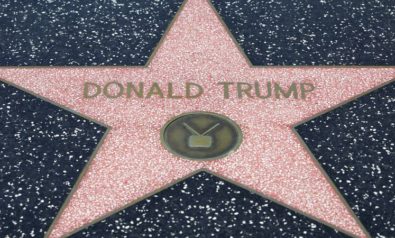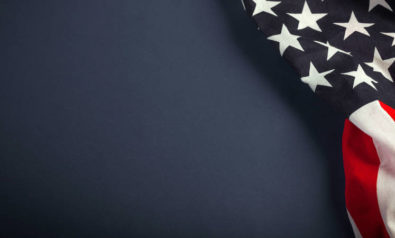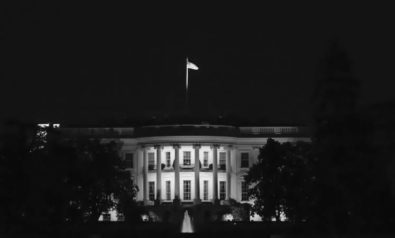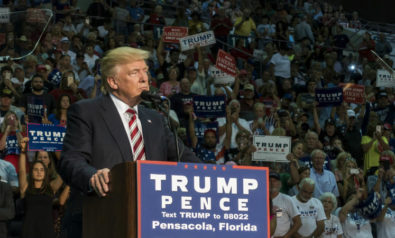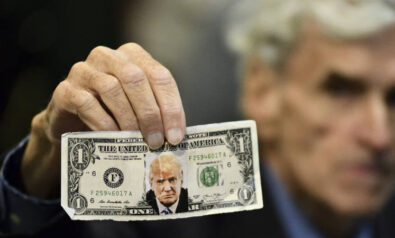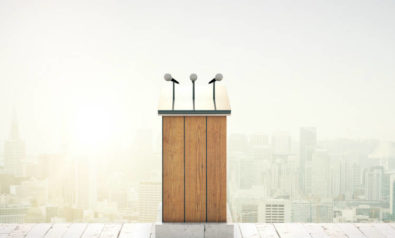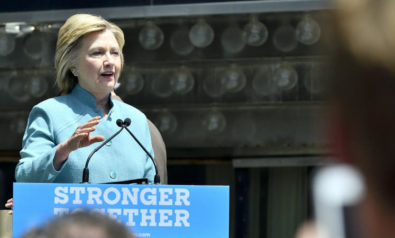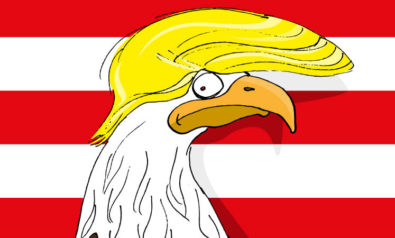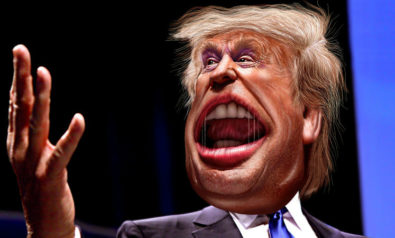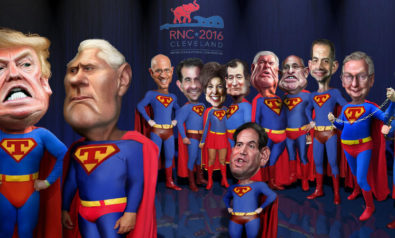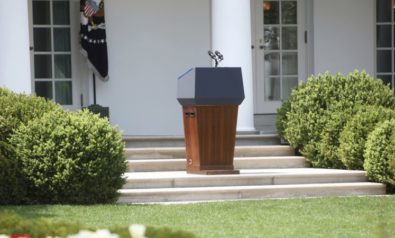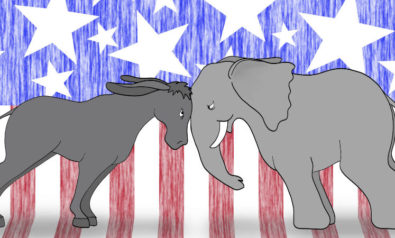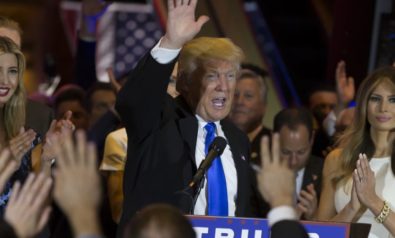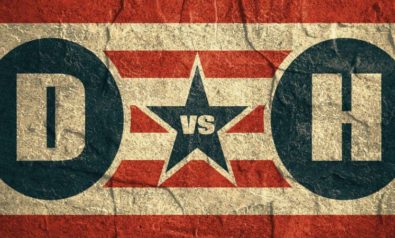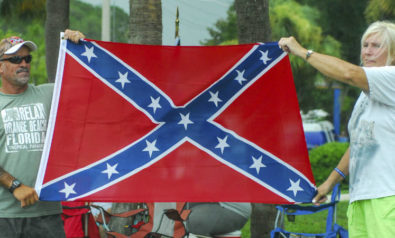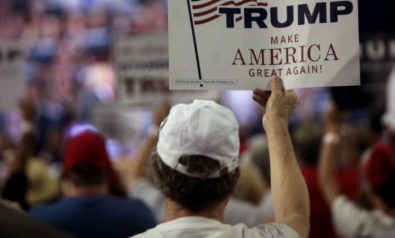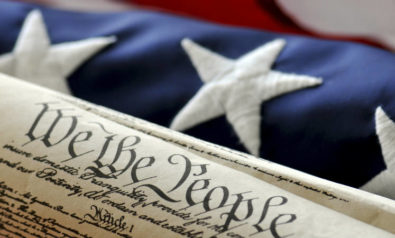Sara El-Yafi provides a 101 on the US election. Are you ready?
Most of you know, even if you’ve never set foot in the United States, that on November 8, the American people will finally decide who will be the next president of the world for the upcoming four years. And that is exciting for all of us, especially in the Middle East, because we really look forward to knowing whether we’ll be getting bombed by a crazy, narcissistic, self-imbued, lying, manipulative scam artist, on one hand, or by Donald Trump, on the other.
Got you there, didn’t I? Ha!
You thought I was describing Trump, didn’t you? Well, that’s precisely the madness of this election. The same insults are interchangeable depending on who you support. Hillary Clinton and Donald Trump are possibly the two most controversial candidates to run for president in modern-day America, and they share one certain thing: the hatred of many.
See my illustration below of a typical casual conversation with an undecided voter.
Indeed, I have personally received many messages from people spewing the most hostile arguments against Hillary whenever I write about the elections that would put a fat internet bully to shame; that woman is hated, rationally hated. And Donald Trump? He should be featured in the Guinness Book of World Records for “most insults amassed by a homo erectus in the shortest span of time.” (See what I did there?) Oh, the vitriol! The data is fascinating, because this election is truly unprecedented not just in terms of insults, but in everything else.
So allow me to try explain the current US election by offering you a full-fledged synthesis about what is going on. When you finish reading this piece, you’ll have a little internet-master’s degree in US politics, which will help you win all bullying fights in the YouTube comments section.
But first, you must understand how democracy works in the United States. Take a deep breath.
NOT A DIRECT POPULAR ELECTION
Most people don’t know this, but America is not a democracy in the traditional sense, and that is quite a shocker considering that it has acted like it wanted to implement democracy almost in every country in the world. The United States is the only country in the world that employs a system in which an executive president is indirectly elected.
In fact, the word democracy is not even mentioned in the Declaration of Independence or in the US Constitution. Why? Because during the time of “the Founders” around 1776—i.e. Benjamin Franklin (guy on the $100 bill, and the “first American”); George Washington (guy on the $1 bill, and first president of the USA); Thomas Jefferson (guy on the $2 bill, author of the Declaration of Independence); Alexander Hamilton (guy on the $10 bill, literally was killed in a duel to be on the $10 bill, and creator of the US economic system); James Madison (no bill for this guy ‘cause he was too short and always was out of camera frame. Kidding, he wrote the “Bill of Rights”, i.e. the first “ten amendments”); John Adams (2nd president of the USA) to name the famous ones of the many “Founding Fathers”—these men believed that the “rule of the people” was probably going to be a bad idea as it would most probably lead to disorder and disruption (remember that the Founding Fathers were also slave-owners).
But since they were combating monarchies, they didn’t want to establish a royal government either; instead they opted for a “democratically-based” government, but not an actual direct democracy.
When the people of the United States go to cast their votes for a president, they are not voting for a president, but instead, they are voting for a particular group of “electors,” whose job is then to vote for a president. It’s a buffer, an added layer composed of traditionally “more knowledgeable and wealthy people” who “knew best”—in case, you know, they ought to overturn the results.
Today, the aura of that group of electors has changed, but that layer still exists, and together these electors are called the “Electoral College.” And only they are the ones who officially vote for the president, in accordance with what the people want.
THE “ELECTORAL COLLEGE” VOTES, NOT THE PEOPLE
All in all, the “Electoral College” is entirely made up of 538 electors. These human beings are the only men and women in the United States whose vote officially counts toward choosing the president of the United States. In every state, every party nominates its own group of electors—i.e. the Republican Party nominates a group of electors, the Democratic Party nominates a group of electors, the Green Party nominates a group of electors, and the Libertarian Party nominates a group of electors. So, every party should technically have their own version of “538 electors.”
These electors are usually state-elected officials, party leaders or people with a strong affiliation with the presidential candidates: Basically, people who won’t stab their party in the back, because there is no constitutional provision or federal law that requires electors to vote according to the results of the popular vote in their states.
Yeah. That’s crazy, I know. This means that a group of electors could technically decide to go rogue if they wanted, and cast their votes for another candidate than the one chosen by their people. If they did, they would be called, “faithless electors.” Google it—it’s awesome.
But assuming that they’re all “faithful” electors, then, depending on which presidential candidate wins their respective state, the corresponding group of electors will cast all their electoral votes for the winning candidate, on the first Monday after the second Wednesday in December. (No kidding. That’s how they do it. This year, that’s December 19.)
Now wait, there’s more. If a political party fails to nominate its group of electors by a certain deadline (for example, the Green Party didn’t meet the deadline in Arizona this year), then, that state cannot vote for that candidate. So, Arizonans this year will not be able to vote for Jill Stein, even if, say, she is the leading candidate in the polls. Weird, complex, and quite undemocratic, I know. “Let’s make democracy hard for everyone” is an American theme.
 Fair Observer provides you deep and diverse insights for free. Remember that we still have to pay for servers, website maintenance and much more. So, donate now to keep us free, fair and independent.
Fair Observer provides you deep and diverse insights for free. Remember that we still have to pay for servers, website maintenance and much more. So, donate now to keep us free, fair and independent.
So how many electors does every state get?
It depends on the state’s population size. Florida has 20 million people, so it gets 29 electors. California has 39 million people, so it gets 55 electors. Vermont has 626,000 people, so it gets 3 electors (which is the minimum), and every elector gets one electoral vote, which only counts in his or her state.
In case you were wondering, every 10 years, the US conducts a new census to check for population variations. So every 10 years, the number of electors in a state often changes based on its population change. Like, in 1990, Florida was allotted 25 electors. In 2000, it increased to 27 electors. In 2010, it increased to 29 electors. And surely in 2020, it will increase even more—that’s because more and more people exist.
So, OK, it’s Election Day in the US, millions of people go vote for their preferred presidential candidate, but their vote only counts toward the state they are registered in. Then, when it’s over, every state counts its own votes. Whichever presidential candidate got the most votes in a state, even if that candidate has won by one vote, will get all the electoral votes of that state. It’s all or nothing. (Except for Maine and Nebraska who do something with proportional electoral votes, whatever, don’t break your head over it. This only matters if there is a tie between the candidates.
Let’s illustrate this with the example of California in 2012, when Barack Obama was running against Mitt Romney. Obama got 7.8 million votes (that’s 60.2%), and Romney got 4.8 million votes (that’s 37.1%). Therefore, Obama won. Thus, all 55 Democrat electors of California cast their vote for Obama because that’s what the people wanted. Resultantly, “Obama got all 55 electoral votes of California.” Get it?
To become the president of the United States, one needs 270 electoral votes. Keep that number in mind: 270.
Here is a map of the United States and the electoral vote count:
Mmm. OK. So, now you’re thinking, “Well, if it’s on “state by state” basis, then surely the states with the most electoral votes have an unfair advantage over states with few electoral votes.”
You’re right! Big population states eclipse small population states. Texas (38 electoral votes), Florida (29 electoral votes) and New York (29 electoral votes) are some of the more popular states that presidential candidates really want to win, because together that’s 96 electoral votes. Whereas states like North Dakota (3 votes), South Dakota (3 votes), Montana (3 votes), Delaware (3 votes), Vermont (3 votes), Wyoming (3 votes), Alaska (3 votes), Hawaii (3 votes), New Hampshire (4 votes), Rhode Island (4 votes) and Maine (4 votes)—all 12 of these states are worth 36 electoral votes together, which is less than Texas alone.
So yes, it’s unfair. It is even possible for a candidate to not get one single vote, not one vote, in 39 states, but become president of the US if he or she wins only the 11 remaining states.
It is indeed unfair for smaller population states, but the rule of the “Electoral College” in the United States can actually be unfair to almost all. And here is the more unfair piece of news:
AN UNFAIR SYSTEM
A presidential candidate can win the highest number of total votes (what we call “popular vote”) in the whole country, but lose the elections. It has happened many times in the history of the United States. That’s what happened to Al Gore in the year 2000 when he was running against George W. Bush.
In 2000, more than 105 million Americans voted in the general election. Al Gore got 50,999,897 votes (that’s 48.38%), and George W. Bush got less—he got 50,456,002 votes (that’s 47.78%). And Ralph Nader got 2,882,995 votes (2.73%). So, basically, Bush lost to Al Gore by 0.6 percentage points, yet he became president of the United States. Why? Because he got more electoral votes in the Electoral College: 271 total electoral votes for Bush versus 266 for Al Gore. So he got the presidency. Unfair? Well, that’s the system of the “Electoral College.”
In the presidential election of 2000, it all hinged on the battle in Florida. If you were around during that year and you were following the US election, you heard a lot about Florida. Florida was the deciding state, and Bush won Florida by 537 ballots. That’s so small—it’s the equivalent of one neighborhood. Bush won because of 0.0005085% of votes.
Many Democrats gave heat to Nader, the third presidential candidate representing the Green Party. They accused him of “taking votes away” from Al Gore all the while knowing that he would never be president—they refer to him as “third party spoiler.” Nader got 97,488 votes in Florida. But his retort was that the number of Democrats in Florida who voted Republican far outweighed the marginally few who voted Green. And he makes a point. It’s not Nader who was at fault; the system is simply not truly democratic.
It is a system that gives almost all the deciding power to “swing states,” like Florida in 2000, to decide the fate of the presidential election. Understanding the quirkiness of swing states, my favorite part…
SWING STATES
There are 50 states in the United States of America, plus Washington, DC (which is not a state, it is a federal district, yet it holds 3 electoral votes). Typically, many states lean toward voting for a certain political party, or at least, historically, they have voted consistently for one specific party’s candidate. These are known as “safe states.”
For example, Oregon, Maryland, Washington, Rhode Island, Massachusetts and California are typically “safe states” for Democrats. Meaning, for the past six elections or more, the Democratic candidate has always won the electoral votes of these five states. We call them “blue states” because they consistently vote “blue”—i.e. Democrat.
On the other hand, Mississippi, Alabama, Louisiana, Kansas, Idaho, Oklahoma and Utah are “safe states” for the Republican candidate. We call them “red states” because they vote “red”—i.e. Republican.
Safe states are never battleground states. So, Obama, in 2012, didn’t even visit Utah, because it’s a losing state for him no matter what he does (72.62% of voters in Utah voted for Romney in 2012). And in the very blue Washington, DC, 91.4% of voters voted for Obama in 2012. In fact, ever since DC started voting in presidential elections in 1964, for 13 straight elections now, it voted blue 100% of the time. No state in the US has ever been this consistent. So, Romney knew he had no business there either. But that is not the case for states like Ohio or Florida, who vote differently every election, or every other election, etc. They are called swing states.
Swing states sway back and forth from one election to the next because the two major political parties have similar levels of support among voters in that state. And almost exclusively, swing states decide the outcome of every US presidential election. Racial diversity is the dominant feature of most swing states.
So, a victory for Trump or a victory for Clinton relies exclusively on getting a winning combination of the following swing states. Some of these are classic swing states, while others are newcomers into the swing group of this election cycle, so I will give you the comprehensive list with some interesting information about each, coloring each with the expected win:
1: Florida (29 votes): The notorious swing state, the emperor of swing states. And currently, the state that holds the tightest race between Trump and Clinton. The weighted average between five most recent reliable polls shows that Clinton is at 45.6% and Trump at 46%. If Clinton loses Florida, she can still be president. But if Trump loses Florida, he has no chance.
2: Ohio (18 votes): Here is a fun fact about Ohio. Since 1900—i.e. for the past 29 presidential elections, Ohio voted “correctly” for the president 90% of the time with the exception of John F. Kennedy in 1960, Franklin D. Roosevelt in 1944 and Herbert Hoover in 1928. This means that for all the other 26 elections, it voted for whoever became president. And this time, Trump is leading in Ohio with 46.4% versus Clinton who is at 44.2%.
3: Nevada (6 votes): Like Ohio, this swing state since 1900 also voted correctly 90% of the time; they are the only two states to have done that. Nevada fares better than Ohio because it voted “incorrectly” mostly at the beginning of the century, namely against William McKinley and Theodore Roosevelt in 1900, against William Howard Taft in 1908 and against Jimmy Carter in 1976. Today, Clinton seems to be leading at 46% versus Trump at 44.2%.
4: Iowa (6 votes): Although Trump literally said in a public speech on the campaign trail, “How stupid are the people of Iowa?” he is leading there big time. Even though Iowa voted for Obama twice, and voted for Bill Clinton twice, they don’t seem to like Hillary very much. Trump is at 44.4% and Clinton is at a lower 41.2%.
5: Colorado (9 votes): Colorado voted for Obama both in 2008 and 2012, and once for Bill Clinton in 1992, but otherwise, it has been voting Republican since 1968 (nine consecutive red elections). However, polls show a lead for Hillary. She is at 43.8% while Trump is at 39.8%, but a few days ago she was higher. It is worth mentioning that Colorado is a state where Bernie Sanders won big against Hillary Clinton, and it is not a very friendly Hillary state.
6: New Hampshire (4 votes): New Hampshire has had an interesting voting history. It voted blue in the past three elections (Obama twice and Kerry once), but red in the election before that (Bush in 2000), but blue again for Clinton in 1992 and 1996, but red from 1968 to 1988 (six elections)—so, OK, it is a swing state. Today, Clinton is winning with 43.4% and Trump at 41.4%. She was higher a few days ago, but Trump is catching up. But just like Colorado, Sanders won the state in the primaries against Clinton. These are variables that are worth holding on to as they may play against Hillary.
7: Pennsylvania (20 votes): Pennsylvania is generally considered a battleground state, even though it has been voting Democrat since 1992. It is a truly bipartisan state as it has the smallest number of independent voters of all states. Clinton leads there at 47.6% versus Trump at 42.4%. A few days ago, Trump was lower in these polls, but is now rising.
8: North Carolina (15 votes): This is a very interesting one. North Carolina is usually a red state. It has been voting Republican for nine straight elections since 1980, except that it voted blue once in 2008 for Obama (who won only by a tiny margin of 0.4%), but then voted red again in 2012 against Obama. The reason why North Carolina is considered a swing state in this election cycle is predominantly because of its African-American millennials, who account for almost 25% of the votes. And they hate Trump. Around 60% of African-American millennials support Hillary Clinton, but only 2% support Trump. So, they are the reason why North Carolina got its swing back, and also, they are the reason why Obama won the state in 2008. As of now, Clinton is leading at 46.6% versus Trump at 45.6%, but this is not a guarantee because just a few days ago she was higher and he was lower, so she is falling and he is rising.
9: Virginia (13 votes): Another new swinger. Virginia was a classic red state for 10 straight elections from 1968 to 2008, then, suddenly, in 2008, it switched, and it voted blue twice in a row for Obama in 2008 and 2012. At this point, Clinton is in the lead at 45.2% versus Trump at 41.2%. Also, Clinton was higher a few days ago, and Trump was lower, and now Clinton is falling and Trump is rising.
10: Michigan (16 votes): Michigan is a less typical swing state. Michigan has been voting Democrat since 1992, i.e. for the past six elections (although it voted Republican for the six elections before that). Today, in line with its recent history, Clinton is in major lead at 45%, while Trump is at 38.8%. This is almost a guaranteed win for Hillary.
11: Wisconsin (10 votes): Like Michigan, Wisconsin has been voting blue since 1988, i.e. for the past seven elections. Today, Clinton leads at 46.4% versus Trump at 40.2%. Also, almost a guaranteed win for Hillary.
12: New Mexico (5 votes): Most websites are not discussing New Mexico as a swing state, but New Mexico may hold a very interesting surprise because it might not vote for either Trump or Clinton, but for Libertarian Gary Johnson. And if that happens, this may be a major upset. Historically, New Mexico voted blue in 2008 and 2012, but red in 2004, and blue again in 1992, 1996 and 2000, but red from 1968 to 1988 (six elections). So it swings.
13: Georgia (16 votes): Another interesting one. Georgia has been voting Republican since 1988 (so for the past seven elections), except that it voted Democrat for Bill Clinton once in 1992. However, Georgia was a blue state all the way from 1852 up until 1984. That’s 24 straight blue elections. So, who knows?
14: Arizona (11 votes): Arizona is, historically, a red state. With the exception of giving its vote to Bill Clinton in 1996, Arizonians voted Republican in every presidential election since 1952 (for the past 16 elections). However, this time around, a growing Latino vote that opposes Trump is bringing it into swing, and polls suggest a much tighter race than in years past.
So, there you have it: the 14 swingers of the US presidential election 2016.
INCREDIBLE MAPS DRAWN BY SARA
This is the map of the United States (that I DREW! Yes, thanks, that’s why it’s not straight) with an estimated distribution of how states will vote on November 8th, minus the swing states (colored in brown). With these safe estimates, Clinton has a guaranteed 195 electoral votes, and Trump a guaranteed 163 electoral votes. If the polls are right, Clinton quickly will amass a majority, but we live in a world where Brexit exists in Britain.
Just by glancing at the polls of swing states, one can see that Hillary has several pathways to victory, while Trump has much less. Here is a probable map accounting for some swing states’ probably leaning, which I have colored in light blue and light red/pink. I left in brown the states that are more likely to be a tossup.
In this case, Clinton is 11 votes away from the presidency—that’s damn close.
Thus, we conclude that to become president, in addition to the “light red” swing states, Donald Trump must win Florida (possible), North Carolina (possible), Arizona (possible), Nevada (possible) and Colorado (very tough) or New Hampshire (tough). A Brexit miracle needs to happen for him.
SYNTHESIS
If Clinton wins, it’s expected, and everything statistically makes sense.
If Trump wins, it will be the most unprecedented presidential victory in the US, and it will be the end of all polling companies.
If Clinton and Trump reach a tie, with 269 votes each, the election would go to Congress, where each state would get a single vote, which would almost certainly elect Trump.
All eyes are on you, America.
Before I leave you, I want to say this. Hillary is leading in the polls, and sure, at this point, it is not a guarantee yet. However, I can guarantee this: the next president of the United States is only serving one term. You heard it here first.
The views expressed in this article are the author’s own and do not necessarily reflect Fair Observer’s editorial policy.
Photo Credit: Sirichoke
Support Fair Observer
We rely on your support for our independence, diversity and quality.
For more than 10 years, Fair Observer has been free, fair and independent. No billionaire owns us, no advertisers control us. We are a reader-supported nonprofit. Unlike many other publications, we keep our content free for readers regardless of where they live or whether they can afford to pay. We have no paywalls and no ads.
In the post-truth era of fake news, echo chambers and filter bubbles, we publish a plurality of perspectives from around the world. Anyone can publish with us, but everyone goes through a rigorous editorial process. So, you get fact-checked, well-reasoned content instead of noise.
We publish 2,500+ voices from 90+ countries. We also conduct education and training programs
on subjects ranging from digital media and journalism to writing and critical thinking. This
doesn’t come cheap. Servers, editors, trainers and web developers cost
money.
Please consider supporting us on a regular basis as a recurring donor or a
sustaining member.
Will you support FO’s journalism?
We rely on your support for our independence, diversity and quality.


